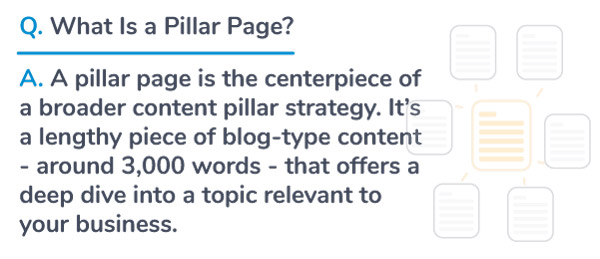What Is a Pillar Page on a Website?
March 25, 2022 •Jeremy Flick

The almighty SEO strikes again! We all know that keywords and phrases bring traffic to web pages, but you can do even more to drive potential customers to your website. SEO pillar pages can enhance your website traffic even further.
A content pillar strategy allows you to build your content into three tiers, each more focused than the last, making you the authority in your industry. By writing a content cluster of pillar pages, sub-pillars, and supporting blogs, you can dominate SEO rankings and sit pretty on the first page for your competitors to see.
So, where do you begin with pillar page design? We’re here to walk you through it.
What Is a Pillar Page?
A pillar page is a streamlined, comprehensive piece of content that allows you to become an authority on any given topic. A pillar page answers specific questions in detail relating to the subject you’re focused on, in about 3,000 words. A pillar page uses high-ranking keywords and questions to drive traffic to your website. Essentially, it’s the ultimate guide that links all other content in the pillar strategy together.
For example, suppose your company makes ceramic mugs for breweries and coffee shops. In that case, you might want to write content focused around ceramics—the history, the processes, or the uses—and tie it in with your business. You need to consider what questions are being asked about ceramics and answer them individually within your pillar page, not only providing more information for the reader but also securing clicks from Google.

In this case, your pillar page would contain information regarding particular topics stemming from ceramics and pave the way for smaller, focused pieces of content such as sub-pillars and supporting blogs.
The benefits of pillar pages are undeniable. A pillar page makes you the go-to expert on a topic while providing customers with in-depth information. And due to SEO content pillar strategies, link internal hyperlinking to your own content, search engines will connect all of your content to your pillar page to ensure your site is on the first page. So to develop a pillar page template, let’s talk about how to write one.
How Do You Write a Pillar Page?
Hopefully, the thought of writing pillar pages isn’t overwhelming. We’ll take you through the steps to make sure your pillar page template is comprehensive and brings traffic to your website.
1). Deciding On a Topic
To use the ceramic mug company as an example, you want to focus on a broad topic like “coffee mugs” to begin. Doesn’t sound like there’s enough to write about? We promise there is!
2). Focusing On Keyword Phrases and Questions
Once you pick your keywords, you’ll be able to write your content! DemandJump provides you the tools to gain insights on what is being searched and allows you to select keywords relevant to your business. Some interesting ceramic mug keywords to consider are “Evolution of mugs” or “Coffee mug meaning.” You can also answer questions like, “When were ceramic mugs invented?” or “What were old mugs made of?” allowing you to focus, in detail, on your broader topic.
3). Structuring Your Page Correctly
We’ll discuss this more in a moment, but making sure your pillar page is structured correctly guides readers and utilizes SEO to its advantage.
4). Connecting the Dots
Once you’ve finished writing your pillar, you need to make sure each topic relates to the piece's title. If you’re writing about the history of mugs, you might save “How does glaze work?” for another pillar page. You can always have more than one pillar page to cover your different offerings.
5). Revising the Content
It’s always best to have someone read your work. A fresh set of eyes can catch issues you may have overlooked and provide you with a different perspective on the content.

How Do You Structure a Pillar Page?
Your pillar page should be organized with headers. Sounds simple right? In web design, there are different types of text headers: Heading 1, Heading 2, Heading 3, etc. The visual result of headers is questions or ideas broken into sections with the text information below them, making it easier to read. However, more importantly, h2s impact your SEO rankings.
Search engines have an easier time ranking a header that is easy to understand and accurately depicts the content of a section. So you want your title to be formatted as h1 and main questions and talking points to be h2s. In our example, “Coffee mugs” should be an h1, and “What were old mugs made of?” should be an h2. Making high-ranking phrases h2s will ensure your content reaches page one.
Create Your Pillar Page With DemandJump
At DemandJump, we make it easy for you to build your own content pillar strategy by creating content optimized for your audience. By providing you with high-ranking keywords and questions, you’re able to drive traffic to your website and reach the first page on search engines.
Get started for free today and see just how easy it can be.
Featured Articles
Categories
- Attribution Tracking (13)
- Channel Optimization (11)
- Consumer Insights (68)
- Content Marketing (251)
- Data Science (8)
- Digital Marketing (6)
- Digital Transformation (26)
- Enterprise (10)
- Lead Generation (14)
- Market Intelligence (8)
- Marketing Analytics (39)
- Marketing Attribution (57)
- Marketing Management (153)
- Marketing Operations (86)
- Organic Search (222)
- Paid Search (52)
- Pillar-Based Marketing (63)
- Programmatic Advertising (9)
- SaaS Content (14)
- SaaS Marketing (29)
- Search Marketing (111)
- SEO Keyword Research (28)
- SEO Pillar (18)
- SEO Strategy (46)
- SMB (5)
- Website Content (12)


